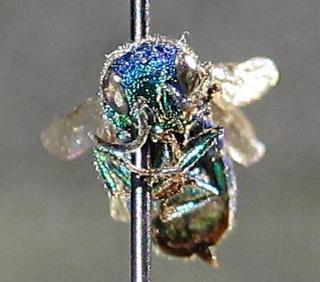
Native Bee Inventory and Monitoring Lab; Photographer: Erika Tucker · 1
Ceratochrysis declinis, face |
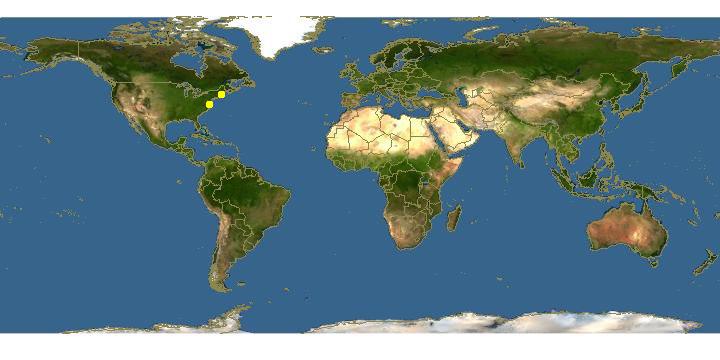
Click on map for details about points.
|
80x5 -
240x3 -
240x4 -
320x1 -
320x2 -
320x3 -
640x1 -
640x2
Set display option above.
Click on
images to enlarge. |
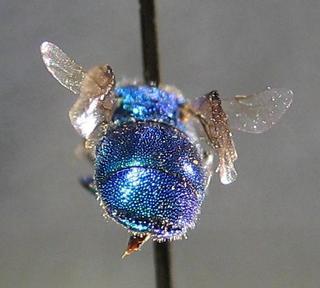
Native Bee Inventory and Monitoring Lab; Photographer: Erika Tucker · 1
Ceratochrysis declinis, tail |
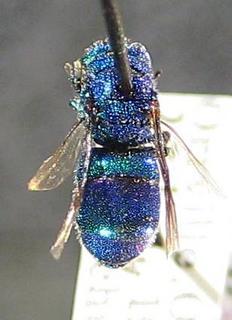
Native Bee Inventory and Monitoring Lab; Photographer: Erika Tucker · 1
Ceratochrysis declinis, top |
|
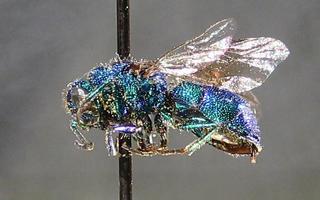
Native Bee Inventory and Monitoring Lab; Photographer: Erika Tucker · 1
Ceratochrysis declinis |
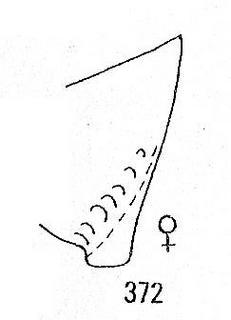
R. M. Bohart and L. S. Kimsey · 1
Ceratochrysis declinis, tail, side |
|
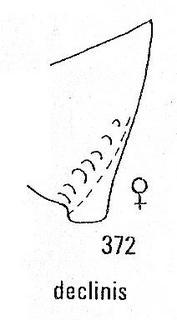
R. M. Bohart L. S. Kimsey, 1982 · 1
Ceratochrysis declinis, tail, side view, R. M. Bohart L. S. Kimsey, 1982 |
|
Overview |
Taken from:
R. M. Bohart and L. S. Kimsey. 1982. A Synopsis of the Chrysididae in America North of Mexico.
Ceratochrysis declinis Bohart
(Fig. 372)
Ceratochrysis declinis Bohart 1966:119. Holotype male, Deerfield Township, Lapeer Co., Michigan (KU).
Discussion: The strongly deflected posterior rim of T-III is characteristic of declinis (fig. 372) and kansensis. Also, the wings are brownish. Differences are the shorter subantennal distance in declinis (1.5 MOD vs. 2.0 MOD) and the tasselled mid and hindtibia in male declinis. F-I length is 3.0 times as long as broad. Male S-VIII is similar to that of bradleyi (see fig. 394). The telomere is unusually slender. Modal body length is 6.0 mm in male, 6.6 mm in female.
Material examined: 78 males including type, 98 females.
Distribution: northeastern U.S. north of 42 (except one record from Gainesville, Florida), west to eastern North Dakota, and the southern tier of Canadian states from Nova Scotia to Saskatchewan. All records are east of the 100th meridian except for Lumsden Saskatchewan at about 105°. The record given by Bohart (l966 of Fort Collins, Colorado was probably in error. C. declinis is one of the only three species of the genus found east of the Mississippi River.
Ceratochrysis Cooper
Chrysis (Ceratochrysis) Cooper 1952:138. Generotype: Chrysis enhuycki Cooper 1952, original designation.
The genus was originally restricted to those species with postocular knobs or tubercles. After a comparative study and consideration of male genitalia, Bohart (1966) enlarged and redefined the genus. Important features of Ceratochrysis are: male paramere distally ligulate and with a weakening at the base of the ligulate part to permit flexing (figs. 360, 385, 398), T-III apex medially notched or entire but not trilobate, transverse frontal carina nearly always present, scapal basin with at least a trace of medial cross ridging, and F-I in both sexes usually 3.0 MOD or more, but at least 2.0. American Trichrysis have similar male genitalia but they have T-III trilobed or tridentate except in such small forms as Trichrysis doriae males which have an incompletely sclerotized discoidal cell. However, the close similarities suggest that the two genera may well have come from common stock.
A character of special significance in the genus, and one that requires close attention, is the degree of roughness on the mesopleuron. This area is not truly smooth in any species, but in a few, such as trachypleura and collega, the lower mesopleuron is distinctly dentate.
As indicated above, male genitalia in Ceratochrysis have the paramere divided into a basimere ending in a weakened spot beyond which is a flexible and ligulate telomere (fig. 360). The cuspis is moderately broad with a sclerotized outer edge. The digitus is stoutly swordlike with teeth usually visible on the outer edge. Specific differences are not striking and lie in the relative length of the telomere as well as in details of the digitus. Sternum VIII has more variation between species. Basically, it is shieldlike with a large basal part and a setose, trilobed or bluntly pointed apical section (fig. 386. 392, 394). In kansensis the apex is deeply trilobed (fig. 402).
This is the second largest genus in the Chrysidinae after Chrysis. About 1,000 males and 1, 500 females have been studied. We are considering 26 species which can be divided with some difficulty into species groups as follows: (1) kansensis and declinis (2) enhuycki (3) faceta, crossata and quadrituberculata (4) perpulchra and trachypleura (5) college, sierrae, concava, fusilis, bradleyi, minata, auriflamrna, and possibly cyanosoma (6) lonimala, longiceps, and grisselli (7) thysana, nearctica, gracilis, menkei, and parkeri and (8)-(9) the unrelated species, bitumida and cavicantha. Since five of the nine categories above contain only one or two species, we are not attempting to define species groups except as they can be recognized from the key.
Host records are meager. Several species have been reared from the eumenid genus Leptochilus in twig or trap nests. Two others have been reported as parasites of the ground-nesting sphecid genus Ammophila. Many of the other small and slender forms probably attack twig nesters, whereas stouter species may be on ground nesters. Much more work on biology is needed.
Distribution of Ceratochrysis over the U.S. is interesting because it is so lopsided. Of the 27 species 24 are known only west of the 100th meridian (97th and 99th in two species), two (enhuycki and kansensis) occur widely on both sides of this line, and one (declinis) is eastern. A few species extend their range into Canada and somewhat more into Mexico and Middle America.
Key to Ceratochrysis
1. T-III apical edge strongly curved under, median notch distinct
.2
T-III apical edge not or gently decurved; if narrowly curved under, median emargination weak or absent
..3
2. Subantennal distance longer than F-II and 1.8-2.0 or more times as long as malar space
(fig. 378)
kansensis (Viereck)
Subantennal distance shorter than F-II and less than twice as long as malar space
...declinis Bohart
3. Vertex or interocellar area with tubercles (figs. 361, 362)
.4
Vertex and interocellar area without tubercles
... 8
4. Interocellar area with a pair of tubercles (fig. 361), no postocular tubercles, both malar and subantennal lengths more than 3 MOD
bitumida Bohart
Interocellar area without tubercles, four postocular tubercles present (fig. 362), malar and subantennal lengths less than 3MOD
.5
5. Abdomen coppery green to red
..faceta (Aaron)
Abdomen blue to green
..6
6. T-III apex broadly emarginate (male) or entire (female)
enhuycki (Cooper)
T-III apex narrowly but rather deeply emarginate
.7
7. Male midtibia and hindtibia with a distal hair tassel (fig. 370), female frons with a carina which is broadly incomplete behind midocellus
.crossata Bohart
Male midtibia and hindtibia without a distal hair tassel, female frons with a strong carina which is nearly complete behind midocellus
quadrituberculata (Cameron)
8. Malar space in female 1.5 MOD or more, in male more than 1.0 MOD (figs. 376, 379)
17
9. Body strongly coppery to red
.auriflamma Bohart
Body blue or purple to green
10
10. Genal carina ending below in a flattened lobe next to mandible base (fig. 374), T-II punctation usually dense
minata Bohart
Genal carina ending simply below, T-II punctation various
...11
11. Pubescent and punctate area of scapal basin less than a fourth of interocular area (fig. 381)
..bradleyi Bohart
Pubescent and punctate area of scapal basin separated in upper half by a zone of cross ridging equal to or greater than a third of interocular area (fig. 383)
...12
12. T-III apex narrowly curved under (fig. 371), weakly emarginate (male (fig. 367) or entire (female); female malar space a little longer than I MOD; female frons coarsely punctured laterally, punctation nearly as coarse as on pronotum
cyanosoma (Mocsary)
T-III apex sometimes slightly deflected but not curved under, notched medially or if entire (female concava), malar space a little less than I MOD; female frons punctation various
...13
13. F-I length not more than three times breadth, T-II punctation slightly separated medially, lower mesopleuron not dentate
sierrae Bohart
F-I length more than three times breadth (figs. 359383), T-II punctation and lower mesopleuron various
14
14. T-II punctation unusually dense medially, punctures contiguous, lower mesopleuron with one or two distinct teeth
collega Bohart
T-II punctation moderately dense medially, punctures slightly separated by polished areas, sometimes a polished median line present; lower mesopleuron somewhat rough but not distinctly dentate
.15
15. Female frons coarsely punctured laterally (punctation nearly as coarse as on pronotum); T-III apically notched in both sexes, notch slightly acute in male; our largest species, body length usually 7 mm or more
perpulchra (Cresson)
16. Face distinctly swollen on either side of central cross ridging, T-III apex obtusely emarginate (male) or practically entire (female)
.concava Bohart
17. Subantennal distance 1.9 MOD or more (figs. 373, 376) transverse frontal carina evanescent, T-II punctation unusually dense medially
.18
Subantennal distance less than 1.8 MOD, transverse frontal carina and T-II punctation various
...20
18. Least interocular distance greater than length of F-I and pedicel together, F-I 3.0 times as long as wide and with long hairs beneath in male (fig. 376), malar space 2.0 (male) to 2. 5 (female) MOD, T-III apical rim entire in female, weakly indented in male
longimala Bohart
Least interocular distance about equal to length of F-I and pedicel together, F-I not pubescent and 5.0 to 6.0 times as long as wide, malar space 2.5 (male) to 3.0 (female)
MOD, T-III apical rim notched in both sexes
19. Subantennal area with an apical subtriangular depression limited above by oblique ridges (fig. 373)
....grisselli Bohart
Subantennal area a little depressed on either side of a median ridge (fig. 382)
longiceps Bohart
20. T-III notch flanked on either side by a sharply toothlike projection (fig. 365), pit row weakly developed, punctation unusually dense over entire tergum
cavicantha Bohart
T-III entire or notch flanked by a rounded tooth (fig. 364) or a smoothly receding edge, pit row well developed, punctation various
.21
21. Lower mesopleuron distinctly dentate, body length usually more than 6 mm
trachypleura Bohart
Lower mesopleuron not distinctly dentate, body length usually less than 5 mm
22. Males, apex of S-IV usually protruding as an apparent pale margin beyond S-III, mid and hindtibiae with distal hair tassels
...23
Females, apex of S-IV usually protruding as a narrow triangle beyond S-III, tibiae without hair tassels, ovipositor sometimes visible
24
23. T-III apex only slightly and broadly emarginate medially
..thysana Bohart
T-III apex deeply and rather sharply incised medially, (fig. 368)
...nearctica (Mocsary)
24. T-III apical margin notched medially
.nearctica (Mocsary)
T-III apical margin entire (figs. 366, 369)
..25
25. T-II nearly as long as broad (fig. 369), T-III middorsal line as seen in side view nearly straight, female only known
..gracilis Bohart
T-II broader than long, T-III middorsal line moderately to strongly saddled in side view
..26
26. Mesopleuron with a strong longitudinal groove separating upper and lower parts
...thysana Bohart
Mesopleuron with a narrow or obsolescent sulcus separating upper and lower parts, females only known
..27
27. Frons with strong punctures largely obscuring central cross ridged area (fig. 384)
menkei Bohart
Frons with a discrete central zone of fine cross ridging (fig. 375)
..parkeri Bohart
|
|
| Supported by | |
Updated: 2024-04-23 12:48:58 gmt
|